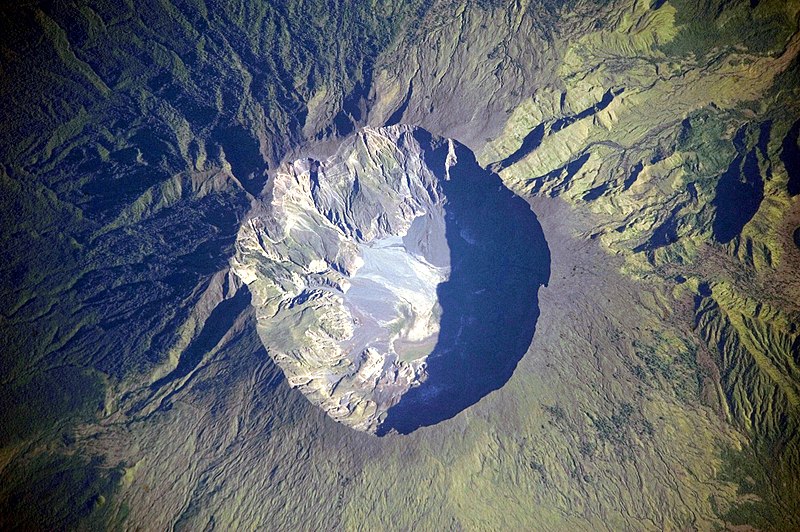| 解説Mount Tambora Volcano, Sumbawa Island, Indonesia.jpg |
Bahasa Indonesia: Foto astronot ini menggambarkan kaldera puncak gunung Tambora. Kaldera ini berdiameter 6 km dan terbentuk dengan dalam 1.100 m ketika puncak Gunung Tambora yang berketinggian kira-kira 4.000 m telah tidak ada, dan ruangan magma di bawahnya menjadi kosong setelah letusan tahun 1815. Saat ini dasar kawah menjadi lokasi sebuah danau air tawar musiman, deposit sedimen yang belum lama, aliran lava kecil, dan kubah yang terbentuk selama abad kesembilan belas dan kedua puluh. Deposit tephra yang berlapis terlihat di sepanjang sisi barat laut bibir kawah. Fumarol aktif, atau ventilasi uap, masih ada di kaldera.
English: This detailed astronaut photograph depicts the summit caldera of the volcano. The huge caldera—6 kilometers in diameter and 1,100 meters deep—formed when Tambora’s estimated 4,000-meter-high peak was removed, and the magma chamber below emptied during the 1815 eruption. Today the crater floor is occupied by an ephemeral freshwater lake, recent sedimentary deposits, and minor lava flows and domes emplaced during the nineteenth and twentieth centuries. Layered tephra deposits are visible along the north-western crater rim. Active fumaroles, or steam vents, still exist in the caldera.
Français : Photographie de la caldera sommitale du mont Tambora, en Indonésie. Cette caldera est immense, avec 6 km de diamètre et 1000 m de profondeur. Sa formation date de l'éruption de 1815, qui est l'éruption volcanique la plus importante de l'histoire. Avant l'éruption, le Tambora formait un pic d'une altitude d'environ 4000 m. Aujourd'hui, les lèvres de la caldera sont à 2500 m d'altitude. Le fond de la caldera est occupé par un lac temporaire, des coulées de laves provenant d'éruptions mineures et des fumeroles.
Deutsch: Krater des Tambora
Русский: Эта фотография подробно показывает кальдеру вулкана Тамбора, имеющую 6 — 7 километров в диаметре. Она образовалась в результате катастрофического извержения 1815 года, когда верхняя часть вулкана обрушилась из-за опустения магматической камеры под ним. Сегодня внутри кальдеры находится небольшое пресноводное озеро, лавовые купола, а в северо-западной части кратера имеются многослойные отложения тефры. Кроме того кальдере присуща фумарольная активность.
 ISS Crew Earth Observations: ISS020-E-06563 ISS Crew Earth Observations: ISS020-E-06563
| Identification
|
| Mission
|
ISS020 (Expedition 20)
|
| Roll
|
E
|
| Frame
|
06563
|
| Country or Geographic Name
|
Indonesia
|
| Features
|
MOUNT TAMBORA, SUMBAWA ISLAND, CALDERA
|
| Center Point Latitude
|
-8.3° N
|
| Center Point Longitude
|
118.0° E
|
| Camera
|
| Camera Tilt
|
27°
|
| Camera Focal Length
|
800 mm
|
| Camera
|
Nikon D3
|
| Film
|
4256 x 2832 pixel CMOS sensor, 36.0mm x 23.9mm, total pixels: 12.87 million, Nikon FX format.
|
| Quality
|
| Percentage of Cloud Cover
|
0-10%
|
| Nadir What is Nadir?
|
| Date
|
2009-06-03
|
| Time
|
00:08:06
|
| Nadir Point Latitude
|
-8.2° N
|
| Nadir Point Longitude
|
119.6° E
|
| Nadir to Photo Center Direction
|
West
|
| Sun Azimuth
|
60°
|
| Spacecraft Altitude
|
189 nautical miles (350 km)
|
| Sun Elevation Angle
|
26°
|
| Orbit Number
|
371
|
| Original image caption
|
| On April 10, 1815, the Tambora Volcano produced the largest eruption in history. An estimated 150 cubic kilometers of tephra—exploded rock and ash—resulted, with ash from the eruption recognized at least 1,300 kilometers away to the northwest. While the April 10 eruption was catastrophic, historical records and geological analysis of eruption deposits indicate that the volcano had been active between 1812 and 1815. Enough ash was put into the atmosphere from the April 10 eruption to reduce incident sunlight on the Earth’s surface and cause global cooling, resulting in the 1816 “year without a summer.”
This detailed astronaut photograph depicts the summit caldera of the volcano. The huge caldera—6 kilometers in diameter and 1,100 meters deep—formed when Tambora’s estimated 4,000-meter-high peak was removed, and the magma chamber below emptied during the April 10 eruption. Today the crater floor is occupied by an ephemeral freshwater lake, recent sedimentary deposits, and minor lava flows and domes emplaced during the nineteenth and twentieth centuries. Layered tephra deposits are visible along the northwestern crater rim. Active fumaroles, or steam vents, still exist in the caldera.
In 2004, scientists discovered the remains of a village, that was once underground but now has resurfaced. They found two adults buried under approximately 3 meters of ash in a gully on Tambora’s flank—remnants of the former Kingdom of Tambora preserved by the 1815 eruption that destroyed it. The similarity of the Tambora remains to those associated with the AD 79 eruption of Mount Vesuvius has led to the Tambora site’s description as “the Pompeii of the East.”
|
|








